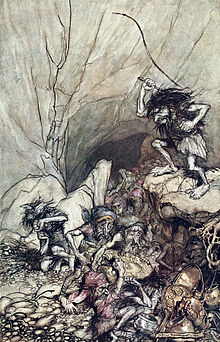InGerman heroic legend,Alberich(German:[ˈalbəʁɪç]) is adwarf.He features most prominently in the poemsNibelungenliedandOrtnit.He also features in theOld Norsecollection of German legends called theThidreksagaunder the name Alfrikr. His name means "ruler of supernatural beings (elves) ", and is equivalent toOld FrenchAlberonorAuberon(EnglishOberon).[1]



The name was later used for a character inRichard Wagner'soperacycleDer Ring des Nibelungen.
Mythology
editAlberich plays a prominent role in theNibelungenlied,where he is the guardian of the Nibelung's treasure and has the strength of twelve men.Siegfriedoverpowers him using hiscloak of invisibility(Tarnkappe), after which the dwarf serves the hero. Siegfried later pulls his beard in mock combat when he arrives unannounced to claim the treasure.[2] Ortnit seeks to woo the daughter of the heathen king Machorel, Alberich reveals his paternity to Ortnit and aids him in his quest, playing tricks on the heathen king and even impersonatingMohammed.When Ortnit sets out on his final fatal adventure against a plague of dragons, Alberich takes back the magic ring and warns Ortnit not to go on his quest.[2]
In theThidrekssaga,Alfrikr makes the swords Eckisax and Nagelringr, giving this last sword toThidrek.[1]
References to Alberich outside of heroic poetry are rare.[1]
Wagner
editInWagner's opera cycleDer Ring des Nibelungen,Alberich is the chief of theNibelungenrace of dwarves and the main antagonist driving events. InDas Rheingold,the first opera in the cycle, he gains the power to forge the ring after renouncing love and stealing the gold of the river Rhein, of which the ring is made. His brother, the smith Mime, creates theTarnhelmfor Alberich. News of the gold robbery and ring of power incites gods and giants alike to action. The giantsFafnerandFasoltdemand the ring in payment for buildingValhalla,and carry offFreiaas a hostage. InGötterdämmerung(the fourth opera in Wagner's cycle),Hagen,the murderer of the heroSiegfried,is the half-human half-dwarf son of Alberich by Grimhilde, a human woman. This detail of Hagen's origin is Wagner's invention, not taken from the myth or epic poems, in which Hagen is an ordinary human being with human parents.
Wagner's Alberich is acomposite character,mostly based on Alberich from theNibelungenlied,but also onAndvarifromNorse mythology.He has been widely described, most notably byTheodor Adorno,as anegativeJewishstereotype, with his race expressed through "distorted" music and "muttering" speech;[3][4][5]other critics, however, disagree with this assessment.[6]
Alberich shows up inRheingold,not inWalküre,then again inSiegfried,and finally inGötterdämmerung(while Hagen is sleeping, commanding Hagen to regain the Ring). At the end of the opera, Alberich along with the three Rhine maidens are the only key characters inDer Ring des Nibelungenthat remain alive. Wotan seems to die at the end ofGötterdämmerungwhen Valhalla goes up in flames, Fasolt fromRheingolddies inRheingold,Sieglinde and Siegmund fromWalküredie inWalküre(Sieglinde is at least dead by the timeSiegfriedbegins, some 15–20 years later), Mime (fromRheingoldandSiegfried) dies inSiegfried,Gunther and Hagen fromGötterdämmerungboth die at the end of it, and Siegfried (fromSiegfriedandGötterdämmerung) and Brunhilde (fromWalküre,Siegfried,andGötterdämmerung) both die inGötterdämmerung.[citation needed]
Legacy
editInWorld War I,the German retreat to fortified positions in theHindenburg Line,which was officially named after Siegfried despite its common name, was named Operation Alberich.[7]
During WWII, Germany developedanechoic tiles,which were nicknamed Alberich.
InGenevieve Cogman’sInvisible Libraryfantasy book series, Alberich is the primary antagonist to the main character, thelibrarianIrene. He is a powerful and mysterious figure whose actions and motives create significant challenges for Irene and her mission to retrieve rare books from alternate worlds.
See also
editNotes
edit- ^abcGillespie 1973,p. 4.
- ^abGillespie 1973,p. 3.
- ^Schausten, Monika (2003). ""Only Germany raises real men for the world": Richard Wagner'sRing des Nibelungen,Nation, and the Third Reich ". In Kosta, Barbara (ed.).Writing against boundaries: nationality, ethnicity and gender in the German-speaking context.Rodopi. pp. 9–27.
- ^Rose, Paul(1996).Wagner: Race and Revolution.Yale University Press. pp. 69–70.
- ^Weiner, Mark (1997).Richard Wagner and the Anti-Semitic Imagination.University of Nebraska Press. pp. 135–143.
- ^See e.g.Cooke, Deryck.I Saw the World End: A study of Wagner'sRing.Oxford University Press. p. 264.
- ^Hayes, Geoffrey; Iarocci, Andrew; Bechthold, Mike (2007-03-23).Vimy Ridge: A Canadian Reassessment.Wilfrid Laurier Univ. Press. p. 10.ISBN9781554580958.
References
edit- Bulfinch, Thomas.1834.Bulfinch's Mythology.Reprinted by New York: Harper & Row, 1970, p. 354–356, 903.ISBN0-690-57260-3.
- Gillespie, George T. (1973).Catalogue of Persons Named in German Heroic Literature, 700-1600: Including Named Animals and Objects and Ethnic Names.Oxford: Oxford University.ISBN9780198157182.
- Guerber, Helene A.1895.Myths of Northern Lands - Index.p. 218,p. 295 index.File retrieved 7/15/2007.